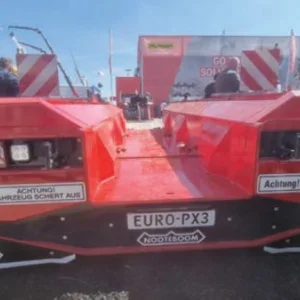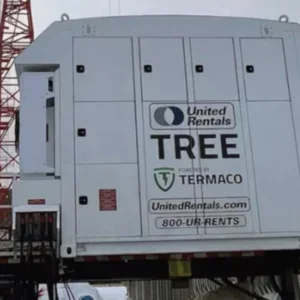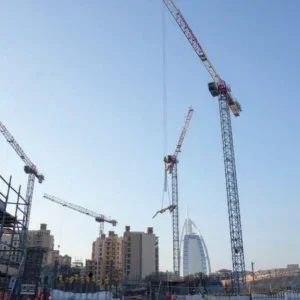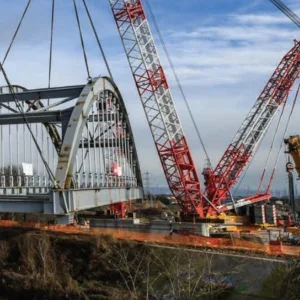Manufacturers’ descriptions of the condition of the Italian mobile and truck loader crane market range from very positive through relatively buoyant to stable. Carlo Locatelli of domestic rough terrain crane manufacturer Locatelli says the Italian market is healthy, partly thanks to government fiscal incentives to buy new machinery. Rough terrain cranes, Locatelli’s main crane product, are in strong demand for domestic projects and also with Italian contractors working overseas. Best sellers are 40t and 50t capacity models. German mobile crane manufacturer Tadano Faun cites the RT market as a good indicator for growth or confidence in Italy and says that in the last 12-18 months it has grown quite strongly, boosted by the new high speed railway network. Italian all terrain and yard crane manufacturer Ormig puts the market as being the same as last year. Some sectors are in growth, others are going down, but in general there is stability, says director Gian Paolo Aschero.
While domestic mobile crane manufacturers are enjoying success, foreign manufacturers still hold the majority of the market. Italy is described as the number one market in Europe by Demag which says that no other country shows a better performance in terms of an increase in the number of new cranes imported from Germany. Demag quotes VDMA figures which show a 71.6% increase in 2001, in the total number of machines, from 81 to 139 units. Demag claims a market share of 38.8% which equates to 54 units.
Liebherr also describes the Italian market as very positive and says that it delivered about 80 cranes in 2001, an increase of about 30% over 2000, according to Georgio Lupi, director of Liebherr Italia. As of February 2002 the order book stood at around 20 new cranes for the year so far. Lupi also expects a further boost to the crane industry this year from the government’s support for investment in new equipment that includes mobile cranes.
And for Tadano Faun the market is relatively buoyant ‘despite the general state of gloom and uncertainty following the September 11 upheaval which has affected a lot of other markets and the general level of international confidence’. Faun says that it increased its AT sales to Italy by 50% in 2001.
The success of foreign mobile crane manufacturers in growing their market share, developing steadily in recent years, is spreading to at least one other sector of the crane industry. Domestic manufacturers of truck loader cranes are facing a similar challenge. Since Hiab changed its distributor arrangement in 1996 turnover in Italy has increased 10 times and it claims to still be gaining market share.
Mobile cranes
Ormig’s current best seller, besides its pick and carry cranes, is the 804 AC, a truly mobile telescopic crane as it is fitted on a commercial truck. Success is attributed to its ability to travel on the road without permits, like a normal truck, and to its 80t maximum capacity, 48m height from the ground, and 32t weight.
Recently launched by Ormig is the 623TTV, a 60t capacity all terrain, with Mercedes-Benz OM 926 LA 240kW Euro II engine, ZF 6WG 210 transmission with torque converter and a Telma Valeo retarder to get the best operating performance on the road and to increase braking capacity. Hydraulics use a Rexroth variable delivery piston pump and two gear pumps which allow simultaneous motion on all functions. It has a new carrier cab design with improved ergonomics and new styling.
New from Locatelli is a range of extras to increase the versatility of the 20t capacity City Crane ATC 20, launched at Bauma last year and most recently shown at the Samoter exhibition in Verona. These are a side-stored 8m boom extension, a folding work platform on the rear of the chassis and pallet forks. This crane has a Euro 3 compliant 240hp (179kW) Iveco engine that gives the ATC 20 a top speed of 68km/h. Also shown at Samoter was the Gril 8125 rough terrain crane that can double as a telehandler. This model is also now available with a fly jib, work platform and forks.
Since Italy’s other construction show, SAIE in mid-October, and the end of February Grove reports sales in the country of around 20 GMK all terrain cranes, by the manufacturer’s two distributors, GRC of Bariano in the north and Fimi of Porto D’Ascoli. GMK cranes, along with ATs from competing manufacturers, are selling for pre-fabrication work, to construct the typical italian warehouses and factories, as well as to rental companies. Recent rental customers for Grove cranes include CAF of Florence, and Forti Sollevamenti which had its latest fleet addition, a GMK 5200, on show at February’s Samoter.
A feature popular in Italy of the GMK 5200, and other GMKs, is the optional hydraulic power-luffing jib which allows the offset or luffing angle to be altered in the air and is controlled from the crane cab. On the GMK 5200 the hydraulic luffing jib gives a maximum lift height of 98m and provides the added versatility that crane rental companies and contractors are looking for, Grove says.
One of these companies is Musselli Dante e Figli, in Voghera, which bought a GMK 5200 in January 2001 and is now awaiting delivery of a GMK 5100, a crane that Grove claims has become the world market leader in the 100t taxi class. In total around 250 units have been delivered since its 2000 launch, Grove claims, and that sales are strong in Italy. A recent customer to have taken delivery is Bettarini of Livorno.
Also popular is the 80t-rated GMK 4075, either as a taxi crane, or with maximum ballast for maximum load capacity work. Pre-fabrication companies and rental fleets, such as Mancini Sollevamenti of Toscana, are recent customers.
At the smaller end of the AT scale a GMK 2035, the two axle 35 tonner assembled in Italy by GRC and fitted with special remote control features, has recently been delivered to Autotrasporti Fratelli Soli in Savignano sul Panaro.
Recent Demag orders in Italy include a TC 2800 truck mounted crane from Delta Besenzoni and another for Comap/Sizilie, an AC 650 from Oiano Lago, and orders for AC 60s from Novalift and Cogemi. Other models recently delivered or on order are 12 units AC 100, several AC 120s and one AC 500-1 for Runco.
One of Demag’s most succesful machines in the country is the 300t capacity AC 300, 14 of which have already been delivered, and orders for several more are on the books, the company claims. Sales of city class cranes are also good: rental house Vernazza now has six AC 40-1s in its fleet.
The strongest market sector for Liebherr is cranes of 100t capacity and above, again used primarily for placing the precast concrete elements used in the construction of industrial buildings. A strong seller is the 100t capacity LTM 1100, of which eight units had been sold this year to February, fitted with two winches and a short fixed fly jib.
Tadano Faun’s success in Italy in 2000 and 2001, with its Parma based agent, Mister Gru, was also mainly in the specialised pre-cast concrete panel assembly market and here models ATF 60-4 (60t), ATF 70-4 (70t) and ATF 100-5 (110t) were popular, to the point of becoming a standard in that industry, Tadano Faun claims. Cranes that are strong, versatile, reliable and uncomplicated (particularly the telescoping systems) are required for this type of heavy-duty work, Tadano Faun says.
The other main market sector, general crane hire, tended to lag behind but picked up towards the end of 2001 and Tadano Faun sold several ATF 30-2 (30t), ATF 60-4, ATF 100-5, ATF 120-5 and the recently introduced ATF 80-4 (80t) model with a single cylinder telescope system on the 48.5m boom. Long booms are usually demanded by the crane hire sector whilst boom length is not so important for pre-cast panel assembly. Tadano Faun says it has been especially successful in Italy with the ATF 100-5, basically because many crane hire companies there need uncomplicated and reliable cranes, with unsophisticated telescope systems, as they do for prefab work. There is still a fear of ‘too much electronics’, according to Tadano Faun.
One small trend was apparent at the end of 2001 and this came from customer requests for cranes equipped for both pre-cast concrete panel work and general crane hire. This means that the cranes begin to resemble Christmas trees, with two winches and two fly jibs: one short, heavy duty fly jib for concrete work (2m-3.5m long); and one normal fly jib. The concrete cranes always have a special short jib and two winches for turning the panels whereas the crane hirers usually prefer a single winch and a long fly jib.
Tadano Faun saw in the market a negative trend in the general level of pricing. Due to the sharp downturn in the German market, some manufacturers have been cutting prices and offering attractive finance to reduce stock. This has also boosted sales in 2001 and 2002 as many customers have brought forward their buying decisions in the favourable market conditions.
2002 has, nevertheless, started well with strong interest in the ATF 80-4, ATF 100-5 and ATF 230-6 (230t). The first ATF 80-4 was delivered last month. The ATF 45-3 (45t) and BKF 35-4 (recovery vehicle) will also be introduced this year into the Italian market.
Tadano Faun is forecasting increases in sales this year in Italy but claims that it is is not under so much pressure to join in the price cutting campaign and hopes that this will not adversely affect the market as as it did just over 10 years ago.
Loader cranes
Domestic manufacturer F.lli Ferrari reports a strong and lively start to 2002, continuing the positive trend of last year. In addition to its domestic market, particularly busy markets in Europe for F.lli Ferrari are France, Greece, Spain and UK. In the export field the company claims the position of leader on the North American market, attributed to an active and profitable cooperation with F.N.A (F.lli Ferrari North America), while Argentina, historically a good market, is suffering with its economic and political situation.
Expectation for 2002 is that sales will surpass those of 2001. Last year closed with a 19% increase over 2000, in terms of the number of units, while turnover, for the second consecutive year, closed with a 50% growth.
Last year also saw strong growth at Effer Holding which increased its group turnover by 21.7% to E72.35m, up from E59.48m the previous year. This came from 500 employees at four factories in Italy and five subsidiaries abroad. Growth for this year is forecast to be 11%, boosted by international expansion (News Nov01, p13).
Effer is aiming to increase the 2,000 units currently manufactured annually to 3,000 cranes in 2004 by concentrating on the sector of the smallest cranes (ratings from 1tm to 10tm). At the moment large cranes (above 40tm) represent 50% of the total production, while 30% is medium units with maximum capacity between 10t and 30t. The company claims to be the leading manufacturer of medium to large truck cranes, its core business at 90% of total turnover, and also of marine cranes, the remaining 10%.
For Hiab the Italian truck loader market is among the three biggest, volume-wise, and is still growing, especially in the segment below 10tm. Italy is also probably Hiab’s most interesting market, it says, being the home for so many truck loader crane manufacturers, including some in the world top ten.
Hiab changed its distribution in Italy in 1996, from a privately owned importer, to a subsidiary, Hiab Italy s.r.l. (now Partek Cargotec s.r.l.). Turnover has increased 10 times, from E1m to E10m, in five years and Hiab claims it is still gaining market share.
In the European loader crane market as a whole, domestic manufacturer Effer attributes the growth of some large foreign (American and Swedish) multinationals to their ability to offer a complete range of products in terms of size and ability. To survive, Italian companies are forced to expand their operational scope and broaden their ranges, the company says, and that the Effer group will be able to compete at a world level through the acquisition of new companies to complete its range.
As for the product itself investment at F.lli Ferrari includes a broadening of the range with the development of a series of marine cranes for installation on boats. Small to medium (3tm to 15tm) cranes will be available, with straight booms from 3tm to 6tm and articulated booms above that up to 15tm. The first unit of this new series has been sold in the UK, a 6tm stiff boom model.
F.lli Ferrari used to be known for its smaller cranes, but it has seen a constant and increasing demand for its mid-range and large models, particularly the 710-728 and 733, complete with, for example, proportional valve banks, radio remote control and fly jib on three hydraulic extensions. In the highly competitive 30tm sector of the Italian market the 733 has performed particularly well, the company says.
For the first few months of this year production at F.lli Ferrari is busy with a major export order for the 710. It is a military application in Asia, details of which are to be revealed in the middle of the year, after the first installations have been completed.
A recent and unusual application for the 710, developed in collaboration with Geismar-Donelli, was for the 710 with three hydraulic extensions to maintain the electric power lines on Bulgarian railways. The crane was installed on a special railway carriage and used to carry maintenance people and to support a telescopic platform.
Meanwhile Effer, over the next three years, plans to launch 11 new models to renew its range and to complete the lineup with small to medium models. On average nearly 19 months is spent getting a crane to market. Investment made to minimise this time includes computer modelling systems. A new profile design for the articulating boom and extensions of the 500/550 models, launched at last October’s SAIE show, uses high tensile steel to save weight Another contribution to weight-saving comes from the use of special materials.
The results of this new technology are particularly apparent at long outreaches. Basic crane versions with up to eight extensions can reach a height of more than 26m. The application of fly-jibs with up to six extensions allows a maximum fully vertical outreach of 34m.
At February’s Samoter exhibition, in addition to the 550, Effer showed a lowered version of a 100N, installed on an 8×2 truck, a 1900N with special installation and the 1150, a large model which Effer claims is the most popular in its class.
And markets outside Italy are a primary focus of Effer, so much so that 80% of sales are from exports, thanks to the five branches abroad, in Denmark, Greece, Singapore, South Africa and the USA and the company intends to increase this figure still further.
The most interesting market for Effer, however, is France, which today makes up 11% of sales. Other good markets are Denmark, Spain, the Middle East, Israel, Belgium and the United States. South America is also important where, working closely with local agents, Effer has been laying down foundations in Venezuela, Argentina, Uraguay and Paraguay for years.
Export markets aside, Hiab claims to have competitive advantages over Italian manufacturers: stemming from its early compliance with the Machinery Directive, from 1995 before it was valid; and it says that the same is happening now with the new standard EN 1299. An example given by Hiab is its XS 700 model, a 70tm crane that stays within the legal height of 4m when mounted on a vehicle, even with a jib attached. ‘So far no Italian competitor can match that’, Hiab claims.
Another example is manual boom extensions which, Hiab claims, it is the only supplier that sells them on a regular basis and that all Italian producers have stopped selling them because they cannot fulfil the regulatory requirement to have overload protection on them. F.lli Ferrari, however, as a topical example, is this month launching an integrated electronic system to control a load applied to mechanical extensions. It will be a device complete with a display to visualise the load applied to the extension and also to the load on the rest of the crane.






